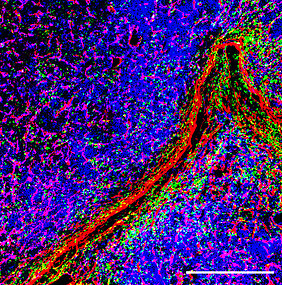Würzburg in the Champions League of Myeloma Researchers
11/14/2023A team of Würzburg cancer researcher Hermann Einsele is part of an international consortium funded by the American Multiple Myeloma Research Foundation with a total of 21 million dollars.

Multiple myeloma is the second most common blood cancer. It develops in the bone marrow and can spread throughout the body. Despite all medical advances, most patients relapse and there is still no cure. The Multiple Myeloma Research Foundation (MMRF) is the largest nonprofit in the world solely focused on advancing scientific and clinical progress in the treatment of multiple myeloma. In early November, the Foundation announced the recipients of three MMRF Myeloma Accelerator Challenge (MAC) Program Grants totaling 21 million dollars and focusing on two critical areas of unmet need in multiple myeloma. The three programmes aim to connect multiple centres, pool their resources and samples, and advance compelling hypotheses that are ready for rapid testing in clinical trials. The University Hospital of Würzburg (UKW) is part of one of these three-year projects, each of which will receive 7 million dollars.
High-risk Patients in the Focus of the European group
"With the grant, we have been accepted into the Champions League of myeloma researchers," comments a delighted Professor Hermann Einsele, Director of the Department of Internal Medicine II of the University Hospital Würzburg (UKW) and spokesperson of the newly founded National Centre for Tumour Diseases (NCT) WERA. He is joined on the Würzburg team by Prof Dr Martin Kortüm, Dr Umair Munawar, Dr Leo Rasche and Dr Angela Riedel. Together with the Erasmus Medical Center in Rotterdam, the University Hospital in Amsterdam and the universities in Turin and Salamanca, they are working to develop a systems biology approach to optimise treatment for high-risk patients with Multiple Myeloma. High-risk patients often relapse early and show inferior survival compared to standard-risk patients.
The European team will define new criteria and new risk factors that allow to early identify high-risk patients with a poor response to current therapy under the leadership of Prof. Pieter Sonneveld, Erasmus Medical Center, Rotterdam. By combining the analysis of different aspects of the disease, researchers will compile an integrated definition of high-risk multiple myeloma, a key step towards new treatments specifically designed for these patients.
The Würzburg Team has Two Million Dollars at its Disposal for This Purpose
An American research group will use cutting-edge technologies to analyse a large cohort of patient samples at the genomic and immune level to understand the critical events that drive high-risk multiple myeloma. The studies have the potential to identify new vulnerabilities that will be further studied using CRISPR gene editing in the laboratory.
In the third MAC grant, another American team is working to improve the identification of high-risk smoldering myeloma (HR SMM). Smouldering multiple myeloma is an early, asymptomatic stage that can progress to active multiple myeloma.
Accelerating the Pace of Research Through Collaboration and Funding
These MAC Grants are a critical new part of this investment, and we are excited that the programs selected will bring together multiple centers to work in highly collaborative networks. Our strategic plan identifies specific research areas that need more attention and only through multi-center collaboration can we rapidly create a large set of patients and samples suitable for new research methods”, says George Mulligan, PhD, Chief Scientific Officer of the MMRF. Michael Andreini, President and CEO of the MMRF adds: "The pace of research needs to accelerate if we are to address the significant unmet needs in multiple myeloma, and the way forward will take collaboration and funding. Bringing together diverse teams through our MAC Grants that normally have many barriers to working together will bring greater focus and scale to these research priorities, yielding more timely and impactful insights for patients.”
About the Multiple Myeloma Research Foundation
The Multiple Myeloma Research Foundation (MMRF) is the largest nonprofit in the world solely focused on accelerating a cure for each and every multiple myeloma patient. We drive the development and delivery of next-generation therapies, use data to drive optimal and more personalized treatment approaches, and empower myeloma patients with information and resources to extend their lives. Central to our mission is our commitment to advancing health equity so that all myeloma patients can benefit from the scientific and clinical advances we pursue. Since our inception, the MMRF has raised over $500 million for research, opened nearly 100 clinical trials, and helped bring 15+ FDA-approved therapies to market, which have tripled the life expectancy of myeloma patients. To learn more, visit www.themmrf.org.
About multiple myeloma and Würzburg's contribution to the research and application of immunotherapies
Multiple myeloma is the second most common blood cancer after leukaemia, in which various malignant tumour foci occur in the bone marrow. The term is derived from the Latin "multiple" for multiple and the Greek "myelos" for marrow. Every year, around 7,000 people are diagnosed with the disease in Germany alone. The risk of developing the disease increases significantly with age. In those affected, malignant plasma cells proliferate and replace normal immune effector cells responsible for producing antibodies. Due to this altered immunity, infections occur more frequently. In addition osteoclasts are stimulated with induce bone destruction, deposition of light chains and full antibodies can lead to damage of nervs, heart and kidneys and a reduction of the red blood cells can lead to fatigue and loss of appetite. Up to date only few patients can be cured. Especially high risk patients tend to relapse early even following intensive and initially very successful therapy. However, with a better understanding of the evolution of these malignant plasma cells diagnosis and treatment will be further improved.






